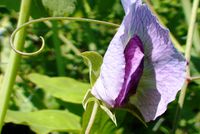Difference between revisions of "Capucijner pea"
From eagle-rock.org
| Line 10: | Line 10: | ||
<gallery caption="" widths="170px" heights="120px" perrow="4"> | <gallery caption="" widths="170px" heights="120px" perrow="4"> | ||
This type of pea is rather rare, but I got some of these peas to try them out. | This type of pea is rather rare, but I got some of these peas to try them out. | ||
| − | |||
First i loosened the soil and added 30 l/m2 worked-out compost to the top layer (peas don't like fresh manure). | First i loosened the soil and added 30 l/m2 worked-out compost to the top layer (peas don't like fresh manure). | ||
| + | File:Photo of package with Capucijner peas seeds.JPG|A package with Capucijner pea seeds | ||
| + | |||
I know that these peas can be dried and kept well and used like kidney beans, but they are much more delicious when harvested fresh and then cooked. | I know that these peas can be dried and kept well and used like kidney beans, but they are much more delicious when harvested fresh and then cooked. | ||
I am a little worried about birds going to eat the peas, as they like the sweet peas and there are loads of birds around my garden. | I am a little worried about birds going to eat the peas, as they like the sweet peas and there are loads of birds around my garden. | ||
Revision as of 08:37, 28 December 2011
Chunks of information
- Here's first some general information about this little-known pea: "During the late Middle Ages, Capuchin monks in Holland and northern Germany devoted considerable energy to the improvement of field peas for agricultural purposes. This has resulted in a group of large-seeded gray peas referred to as Capuchin, especially those from the Netherlands where the breeding of new pea varieties became a national pastime by the early 1600s. One of the classic peas from this group and one which dates from the 1500s is the handsome blue pod Capucijner, a soup pea growing on six-foot (two m) vines." - source
Diary sowing capucijner peas
- This type of pea is rather rare, but I got some of these peas to try them out.
- First i loosened the soil and added 30 l/m2 worked-out compost to the top layer (peas don't like fresh manure).
- I know that these peas can be dried and kept well and used like kidney beans, but they are much more delicious when harvested fresh and then cooked.
- I am a little worried about birds going to eat the peas, as they like the sweet peas and there are loads of birds around my garden.
- Here a quote from a Wikipedia article:
Gallery
See also
External links
- Capucijner pea Research Topics
- Pisum sativum (Blue Pod Capucijner Pea)


